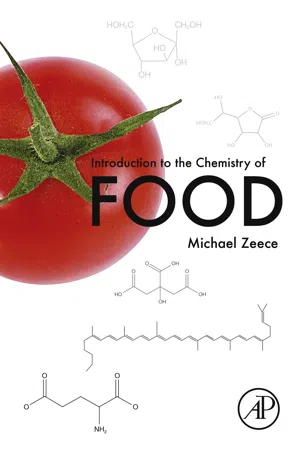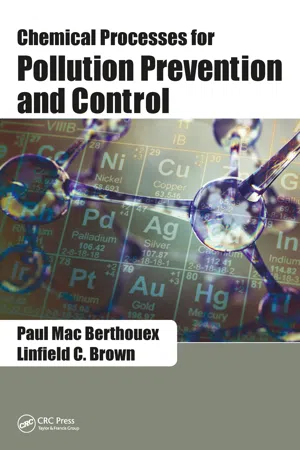Chemistry
pH Change
pH change refers to the alteration in the acidity or alkalinity of a solution. It is measured on a scale from 0 to 14, with 7 being neutral, values below 7 indicating acidity, and values above 7 indicating alkalinity. pH change can be caused by the addition of acids or bases, chemical reactions, or environmental factors.
Written by Perlego with AI-assistance
Related key terms
9 Key excerpts on "pH Change"
- eBook - ePub
Environmental Process Analysis
Principles and Modeling
- Henry V. Mott(Author)
- 2013(Publication Date)
- Wiley(Publisher)
eq ).Given the electrochemical nature of the measurement technique, the measured abundance is in fact the chemical activity of the protons in the solution. We have encountered this chemical activity term earlier and determined that detailed consideration must wait until chapter 10 of this text when we are more fully armed with understandings allowing us to fully appreciate its significance. Thus, for now we will revert to the more familiar definition that pH = −log10 [H+ ] (and the reverse that [H+ ] = 10–pH ), leaving examination and application of the true definition that pH = −log10 {H+ } (−log10 of the molar activity of hydrogen ions) until we embrace the advanced topics of Chapter 10.We could delve into the specific electrochemistry of the pH meter, developing full understandings regarding the bases of the measurement process, but will not. These understandings are published in numerous sources. Although vital to the overall understanding of and refinement of methods for the measurement of pH, assimilating these understandings is beyond the scope of this textbook.Let us examine the hydrogen ion (or proton) in light of the discussion of Chapter 2 relative to the attraction of water to ions in aqueous solution. Once its electron is donated from the hydrogen atom, what remains is the proton situated in the nucleus of the ion with a residual unit positive charge. Then, in aqueous solution, water molecules arrange themselves via short-range bonds between the partial negative of the oxygen and the positive charge of the proton. The first four water molecules tend to orient themselves in a tetrahedral structure. The bonds between the coordinating water molecules and the proton are quite strong. We will leave the computation of the bond energy to the physical chemists. Given that these first four water molecules in no way satisfy the positive charge, additional water molecules are free to orient with the resultant proton–water structure, forming another layer, still strongly bonded to the positive charge, but certainly less so than the inner four. Additional layers of water, each with successively weaker bonds, are added to the overall positively charged ionic structure. In discussions of the relation between the ionic content of water and the activity coefficient (relating molar activity to molar concentration), Dean (1992) lists the ion size parameter (the hydrated radius) of the hydrogen ion as nine angstroms (Å). We can then envision (this works best if we close our eyes and imagine that we can see both the proton and the water molecules) a layered sphere, each layer being a spherical shell, of ordered water molecules surrounding the proton. Within each shell the oxygen atom of each water molecule would tend to be oriented toward the center relative to the hydrogen atoms. Figure 6.1 is a two-dimensional, quite simplistic representation of the general configuration. Given that the water molecules, as a consequence of their innate energy manifest as translational, rotational, and vibrational motion are always on the move, the structure would be dynamic with continual exchange of water molecules. Further, rather than orient in “layers” the water molecules might tend to orient in a much less ordered manner. Regardless of the details, we leave Figure 6.1 - eBook - ePub
- Tony Farine, Mark A. Foss(Authors)
- 2013(Publication Date)
- Routledge(Publisher)
When using the pH scale, a number of points must be considered. First, since it is a logarithmic scale, every change of one unit in pH represents a tenfold change in hydrogen ion concentration, a change of two units in pH a 100-fold change in hydrogen ion concentration, and so on. For this reason, the normal range of blood pH (7.35–7.45) is not as narrow as it first appears, and apparently small changes in blood pH represent large changes in hydrogen ion concentration, which you may need to report. Second, the pH scale is a negative scale – that is, a falling pH represents a rise in hydrogen ion concentration and a rising pH represents a falling hydrogen ion concentration.Pure water has a pH of 7 and an identical concentration of hydrogen ions and hydroxide ions, and therefore is referred to as neutral . If hydrogen ions are added, then [H+ ] rises and pH falls – that is, acids have a pH of less than 7. In contrast, if hydrogen ions are removed, then [H+ ] falls and pH rises – that is, bases have a pH of greater than 7.Salts as acids and basesWhen acids and bases react together, the salt (ionic compound) formed may be neutral, acidic or basic, depending on the strengths of the acid and base used in the reaction. If a strong acid is added to a strong base, or a weak acid is added to a weak base, then the resultant salt is neutral. In contrast, the reaction between a strong acid and a weak base results in the formation of an acidic salt, while the reaction between a weak acid and a strong base produces a basic salt.Acid–base balanceIn-text review Acids are substances that donate hydrogen ions during a chemical reaction.Bases are substances that accept hydrogen ions during a chemical reaction.Acids and bases are described as weak or strong, depending upon the extent of their dissociation.A solution of an acid or base can be concentrated or dilute, irrespective of whether the acid or base is strong or weak.Acids and bases react together to produce a salt and water.The concentration of hydrogen ions is described in terms of pH.We have already looked at the concept of homeostasis in Chapter 2 - eBook - ePub
Soil Science
Methods & Applications
- David L. Rowell(Author)
- 2014(Publication Date)
- Routledge(Publisher)
Section 8.1 explains the terms involved. It should be noted that when applied to soils, ‘neutral’ is given a slightly different meaning, being a range from about pH 6.5 to 7.Soil acidity involves more than just the pH of the soil solution. This is still the main principle and the measurement of soil pH (Section 8.1 ) is normally made in a suspension of soil in water such that the value obtained is primarily related to the solution pH. However, hydrogen ions are also present on cation exchange sites and have an effect on the measurement. Also as soils become more acidic (pH 7 → 3), there are associated changes in the following properties:• The amounts of exchangeable Ca2+ and Mg2+ decrease. These together with exchangeable K+ , Na2+ and are known as the basic cations: their total amount is often expressed as a percentage of the CEC which is termed the percentage base saturation (Section 8.2 ).• The amount of exchangeable Al3+ increases and is often expressed as the percentage aluminium saturation of the ECEC (Section 8.2 ).• The negative charge on humus decreases and the positive charge on sesquioxides increases (Sections 7.1 and 7.5 ).• The availability of plant nutrients is changed. For example, phosphate solubility is reduced (Ch. 10 ).• The availability of toxic elements is changed. For example, aluminium and manganese become more soluble in acid soils (Section 8.3 ).• The activity of many soil organisms is reduced resulting in an accumulation of organic matter, reduced mineralization and a lower availability of N, P and S. THE DEVELOPMENT OF SOIL ACIDITYIn pure water the concentration of H+ ions is 10−7 mol 1−1 and the pH is 7. When in contact with the atmospheric concentration of CO2 a dilute carbonic acid solution is formed with a pH of 5.6. Distilled or deionized water in the laboratory therefore has a pH of about 5.6. For the pH to differ from this value some other acid or base must be present. Thus ‘acid rain’ contains nitric and sulphuric acid dissolved from the atmosphere (or ammonia and oxides of N and S which can form these acids). Its pH is below 5.6; the average pH of rain over eastern Britain is about 4.4 (DOE, 1990). Even in unpolluted air rain picks up small amounts of naturally occurring acid and has a pH of about 5. Ammonia and oxides of N and S are also deposited dry on vegetation and soil and are washed into the soil by rain where they produce acidity. Thus the atmosphere is an external source of acidity (Fig. 8.1 - eBook - ePub
- Michael Zeece(Author)
- 2020(Publication Date)
- Academic Press(Publisher)
Writing numbers this way is tedious and leads to mistakes (e.g., adding or leaving out a zero) that are avoided by using exponential (scientific) notation as shown below. 0.000000 1 M H 3 O + = 1.0 × 10 − 7 M H 3 O + pH and measuring acidity pH is the term used to express the measurement of hydronium ion concentration in solution. The chemical definition of pH is given as “the negative log of the hydronium concentration” and corresponds to the following equation. pH = − Log [ H 3 O + ] This equation of acidity is very useful and often employed to find the pH of materials (in solution) including water, soil, and food. The hydronium ion concentration of pure water at 25 °C is 1.0 × 10 − 7 M. Using the equation for pH, the value for water under these conditions is 7. pH = − Log [ 1.0 × 1 0 − 7 M ] pH = − (− 7) pH = 7 This equation can be used to find the pH of soda pop and egg white, as shown below. Soda pop contains phosphoric acid and is an acidic food. The hydronium ion concentration of a typical pop is 1.0 × 10 − 4 M, therefore its pH is: pH = − Log (1.0 × 1 0 − 4 M) pH = − (− 4) pH = 4 Egg white, in contrast to soda pop, represents one of the few alkaline foods. This means it contains a enough base to raise its pH above 7. The hydronium ion concentration of egg white is 1.0 × 10 − 8 M. Therefore, its pH is: pH = − Log (1.0 × 1 0 − 8 M) pH = − (− 8) pH = 8 The pH scale ranges from 1 to 14, with pH 1 being very acidic and pH 14 being strongly basic (alkaline). One of the only places to find a substance with a pH of 1 is inside the stomach. Its digestive fluid contains HCl and the pepsin enzyme essential to digestion. The highly acidic environment denatures proteins and makes their breakdown by pepsin more effective - eBook - ePub
- M. Bazin(Author)
- 2018(Publication Date)
- CRC Press(Publisher)
14In addition to playing a key role in influencing the performance of biological waste treatment processes, extremely low and high hydrogen ion concentrations adversely affect the aquatic life in receiving waters. In order to assure a satisfactory environment for such life forms, most of the states have regulatory pH standards for municipal as well as industrial effluents that are intended for discharge into receiving waters.II. Chemistry
The term pH is defined as follows:p H = - log [H +]( 1 )where [H + ] is the concentration of hydrogen ions in terms of mol/l . In the strictest sense, activity of hydrogen ions should be used in the definition, however, for practical purposes, molar concentrations approximate activities. The pH scale ranges from 0 to 14 with pH 7 representing neutrality. Those pH values which are less than 7 are acidic, and those greater than 7 are alkaline.A. Acid-Base Equilibria
According to commonly used Bronsted-Lowry theory, an acid is defined as a proton donor and a base as a proton acceptor. As a general rule, any species (for example, HA) that can donate a proton, on dissociation, gives a species (A- - eBook - ePub
- Clyde Frank(Author)
- 2012(Publication Date)
- Academic Press(Publisher)
− ions. Although acidity and basicity of a solution can be expressed in terms of pOH it is customary to use the pH scale.Table 8-3 pH-pOH ChartIt is possible to have negative pH values which means that the H3 O+ concentration is greater than 1 M. However, this is not common since very concentrated solutions of strong acids are not fully dissociated. Second, the approximation that the activity of H3 O+ and concentration of H3 O+ are equal, that is the activity coefficient is 1 (see Chapter 3 , page 27), is no longer valid in concentrated solutions.pH OF ACID AND BASE SOLUTIONS
Strong Acids and Bases
Strong acids and bases are classified as strong electrolytes, which means that they are virtually 100% dissociated in water. Thus, for a strong acid, such as hydrochloric acid, the concentration of hydronium ion in water is equal to the original analytical concentration of the acid. A strong base solution can be described in the same way. Therefore, the pH for solutions of strong acids and bases are easily calculated since the hydronium or hydroxide ion concentrations are arrived at directly from the analytical concentrations of the strong acid or base.Example 8-1
Calculate the H3 O+ , OH− , pH, and pOH for 100 ml of 0.0250 F HCl solution.Example 8-2
Calculate the pH and pOH for the solution made by mixing 400 ml of water and 200 ml of 0.0500 F NaOH. Assume that the volumes are additive.For very dilute solutions, < 10−6 M , of strong acids or bases the ionization of water and its contribution to the equilibrium concentration of [H3 O+ ] and [OH− - eBook - ePub
- Odd-Ivar Lekang(Author)
- 2019(Publication Date)
- Wiley-Blackwell(Publisher)
This is actually not exactly correct due to the fact that the total concentration is not exactly 14 as can be seen from above. It is temperature dependent, and at low temperatures (0 °C), pH 7 will be slightly acidic: Example The pH in pure water not affected by the atmosphere or any buffering system (explained later) shall be found. The water temperature is set to room temperature: In pure water the concentration of H + and OH − must be equal, meaning Figure 5.1 The pH scale. Example It is 10 −14 mol/L H + ions in the water. What is the pH? pH = −log 10 (H +) pH = 14 It is 10 −8 mol/L H + ions in the water. What is the pH? pH = 8 It is 10 −6 mol/L H + ions in the water. What is the pH? pH = 6 It is 10 −2 mol/L H + ions in the water. What is the pH? pH = 2 This shows that for 1 pH unit the concentration of H + ions is changing by 10. Example The water has a pH of 6. Find the number of OH − ions in the water with a temperature of 20 °C. Even at pH 2, there is still a very limited amount of free H + ions in the solution, 0.01 mol/L, compared to the amount of water molecules, 55.5 mol/L. 5.2.3 The carbonate system Natural water will however not be completely pure because gases in the atmosphere, the earth/rock/soil where water is draining through and biological processes in the water interact with the water and affect the composition (add substances). Looking at the gases in the water first, there is an important equilibrium between the CO 2 gas in the atmosphere and the CO 2 concentration in the water. This is described by Henry's law (see chapter 12) and states that if there is CO 2 in the atmosphere above water surface, some of this gas will be transferred and dissolved in the water, assuming available surface for gas transfer and enough time for this gas transfer to take place - eBook - ePub
Chemistry
Concepts and Problems, A Self-Teaching Guide
- Richard Post, Chad Snyder, Clifford C. Houk(Authors)
- 2020(Publication Date)
- Jossey-Bass(Publisher)
The pH, sometimes called the “hydrogen ion exponent,” is defined mathematically as the negative logarithm to the base 10 of the hydrogen ion concentration. For the following H + ion concentrations, compare the power of 10 exponent with the corresponding value of pH. Answer: 6 If the hydrogen ion concentration is 1 × 10 –(exponent), then the pH is equal to the exponent. Or, expressed another way: If a solution has a pH of 3, what is the hydrogen ion concentration? _____ Answer: [H + ] = 1 × 10 −3 M What is the pH of pure neutral water? __________ Answer: A solution is acidic if [H + ] is greater than 1 × 10 −7 M. A solution is alkaline if [H + ] is less than 1 × 10 −7 M. Is a solution with a pH of 6 acidic or alkaline? __________ Answer: acidic (The [H + ] = 1 × 10 −6, which is greater than 1 × 10 −7.) To determine the pH of a solution if the [H + ] is something other than 1 × 10 –(exponent) requires use of common logarithms (log to the base 10). Some instructors may arrange problems so that all [H + ] will be 1 × 10 –(exponent) to simplify calculations. More often than not, [H + ] is something other than 1 × 10 –(exponent). We have chosen such examples and included a log table for your use in the Appendix. You may also use your scientific calculator or the handy calculators available on the Internet by way of a web browser and search engines. In this book, the answers to problems involving logarithms will assume you understand and know how to use logarithms. To determine the pH of a hydrogen ion concentration of n × 10 –(exponent), where n is a number other than 1, we must determine the logarithm of the number n. Determine the pH of a solution if [H + ] = 3 × 10 −5 (to the nearest hundredth) - Paul Mac Berthouex, Linfield C. Brown(Authors)
- 2017(Publication Date)
- CRC Press(Publisher)
− ], and vice versa. For example,[H+ ] = 10−2 and [OH− ] = 10−12[H+ ] = 10−3 and [OH− ] = 10−11[H+ ] = 10−9 and [OH− ] = 10−5where [H+ ] = hydrogen ion concentration (mol/L)[OH− ] = hydroxyl ion concentration (mol/L)KWis temperature dependent, as shown in Table 7.1 .TABLE 7.1The Ionization of Water (KW) Is a Function of Temperature7.4 pH
pH is a fundamental characteristic of chemical solutions. It determines the extent of ionization of soluble compounds and the formation of solids by ions that tend to precipitate. Low pH indicates acidic conditions.The definition of pH ispH = −log10 [H+ ]This convenient “p” notation saves us having to write the concentrations as exponentials. The “p” comes from “potential,” and the formula −log10 [X ] is used in other cases where logarithmic values are easier to understand.Taking negative logarithms of the equilibrium expression for water,
The pH scale for aqueous solutions runs from 0 to 14. A change of one pH unit represents a 10-fold change in [H+].KW= [H+ ][OH− ] = 10−14gives −log10KW= −log10 [H+ ]−log10 [OH− ] = 14and pKW= pH + pOH = 14At pH = 2 [H+] = 10−2 and [OH− ] = 10−12pH = 3 [H+ ] = 10−3 and [OH− ] = 10−11pH = 9 [H+ ] = 10−9 and [OH− ] = 10−5Table 7.2 shows howKWand the neutral pH depend on temperature. Even though the pH of pure water changes with temperature, it is still neutral. In pure water, there will always be the same number of hydrogen ions and hydroxide ions. That means that the pure water remains neutral even if its pH Changes.We are strongly conditioned to the idea of 7 being the pH of pure water, and anything else feels strange. Remember that if the value ofKW
Index pages curate the most relevant extracts from our library of academic textbooks. They’ve been created using an in-house natural language model (NLM), each adding context and meaning to key research topics.








